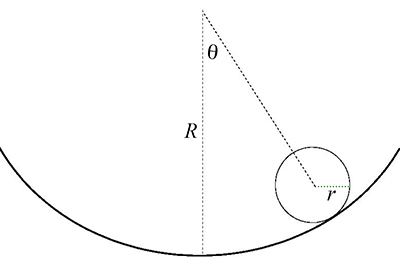Simple Harmonic Motion
Problem 1
A spherical ball of radius \(r\) and mass \(M\), moving under the influence of gravity, rolls back and forth without slipping across the center of a bowl which is itself spherical with a larger radius \(R\). The position of the ball can be described by the angle \(\theta\) between the vertical and a line drawn from the center of curvature of the bowl to the center of mass of the ball. Show that, for small displacements, \(\theta (t)\) is harmonic and find the frequency of oscillation.

› View/Hide Hint
The simplest way to do this problem is to obtain the equation of motion from conservation of energy.
› View/Hide Answer
\( \omega = \sqrt{\frac{5}{7}\frac{g}{(R - r)}} \)
Problem 2
A massive bird lands on a taut light horizontal wire. You observe that after landing the bird oscillates up and down with approximately simple harmonic motion with period \( T \).
You also notice that during the initial oscillations the maximum height the bird reaches above its position at landing is equal to the distance below its landing position at which the bird finally comes to rest, when all oscillations have stopped.
In terms of only \( T \) and \( g \), the acceleration due to gravity, estimate the magnitude of the vertical velocity \( {v_0} \) that the bird had at the instant of landing on the wire.
› View/Hide Hint
You are told that after landing the bird oscillates with approximately simple harmonic motion.
› View/Hide Answer
\( v_0 = \frac{\sqrt{3}gT}{2 \pi} \)








